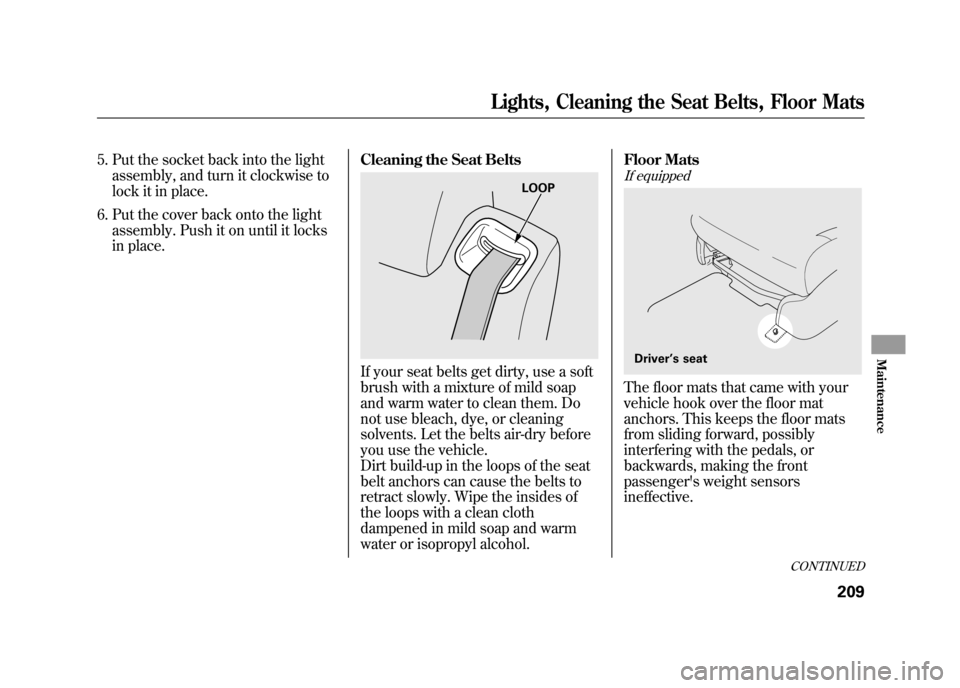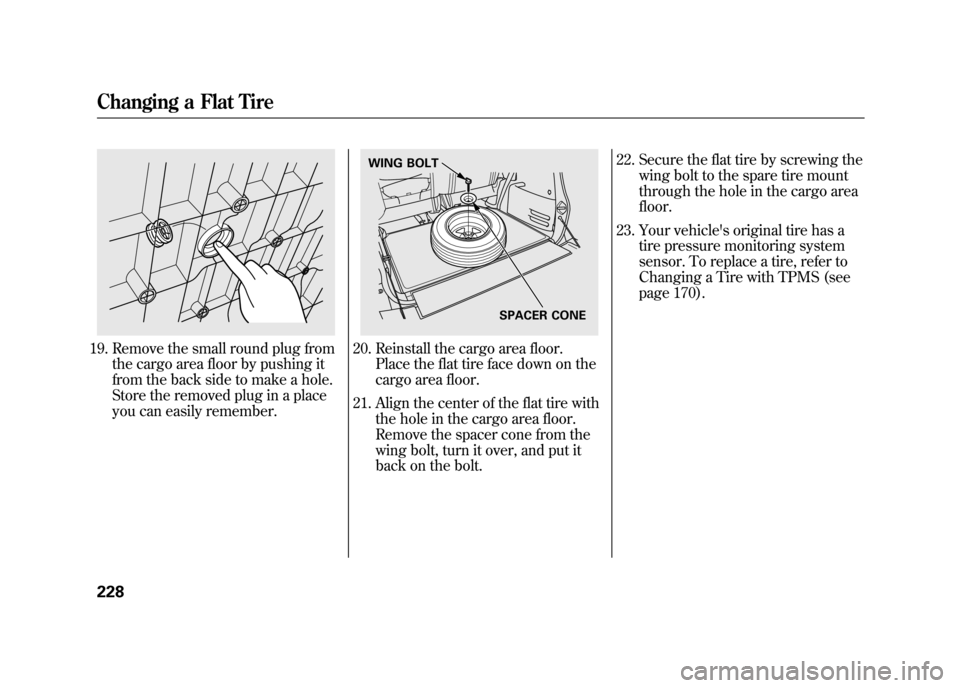sensor HONDA ELEMENT 2011 1.G User Guide
[x] Cancel search | Manufacturer: HONDA, Model Year: 2011, Model line: ELEMENT, Model: HONDA ELEMENT 2011 1.GPages: 286, PDF Size: 14.07 MB
Page 40 of 286

●Do not remove or modify a frontseat without consulting your
dealer.
This could make the
driver's seat position sensor or the
front passenger's weight sensors
ineffective. If it is necessary to
remove or modify a front seat to
accommodate a person with
disabilities, first contact Honda
Automobile Customer Service at
(800) 999-1009.
Additional Information About Your Airbags3410/08/06 08:34:41 11 ELEMENT MMC North America Owner's Man 50 31SCV680 enu
Page 74 of 286

Outside Temperature IndicatorOn EX modelThis indicator displays the outside
temperature in Fahrenheit.
The temperature sensor is in the
front bumper. The temperature
reading can be affected by heat
reflection from the road surface,
engine heat, and the exhaust from
surrounding traffic. This can cause
an incorrect temperature reading
when your vehicle speed is under 19
mph (30 km/h). When you start your
trip, the sensor is not fully
acclimatized, therefore it may take
several minutes until the proper
temperature is displayed.In certain weather conditions,
temperature readings near freezing
(32°F, 0°C) could mean that ice is
forming on the road surface.
If the outside temperature is
incorrectly displayed, you can adjust
it up to
ꭗ5°F warmer or cooler.
NOTE: The temperature must be
stabilized before doing this
procedure. To adjust the outside temperature
indicator, make sure the odometer is
shown in the display, then press and
hold the select/reset knob for 10
seconds. The following sequence will
appear for 1 second each: 0, 1, 2, 3, 4,
5,
-5, -4,-3,-2,-1, 0.
When the temperature reaches the
desired value, release the select/
reset knob. You should see the new
outside temperature displayed.Gauges6810/08/06 08:34:41 11 ELEMENT MMC North America Owner's Man 50 31SCV680 enu
Page 160 of 286

Carrying Items in the Passenger
Compartment●Store or secure all items that could
be thrown around and hurt
someone during a crash.●Be sure items placed on the floor
behind the front seats cannot roll
under the seats and interfere with
the pedals, the seat operation, or
the proper operation of the sensors
under the seats.●Keep the glove box closed while
driving. If it is open, a passenger
could injure their knees during a
crash or sudden stop.
●If you fold the rear seats down or
up, or remove them, tie down
items that could be thrown about
the vehicle during a crash or
sudden stop. Also, keep all cargo
below the bottom of the windows.
If it is higher, it could interfere
with the proper operation of the
side curtain airbags.
Carrying Cargo in the Cargo Area
or on a Roof Rack●Distribute cargo evenly on the
floor of the cargo area, placing the
heaviest items on the bottom and
as far forward as possible. Tie
down items that could be thrown
about the vehicle during a crash or
sudden stop.
●If you carry large items that
prevent you from closing the
tailgate or the hatch, exhaust gas
can enter the passenger area. To
avoid the possibility of carbon
monoxide poisoning, follow the
instructions on page 52.●If you carry any items on a roof
rack, be sure the total weight of
the rack and the items does not
exceed 75 lbs (34 kg).
If you use an accessory roof rack,
the roof rack weight limit may be
lower. Refer to the information that
came with your roof rack.
Carrying Cargo15410/08/06 08:34:41 11 ELEMENT MMC North America Owner's Man 50 31SCV680 enu
Page 175 of 286

Your vehicle is equipped with a tire
pressure monitoring system (TPMS)
that turns on every time you start the
engine and monitors the pressure in
your tires while driving.
Each tire has its own pressure sensor
(not including the spare tire). If the
air pressure of a tire becomes
significantly low, the sensor in that
tire immediately sends a signal that
causes the low tire pressure indicator
to come on.
Low Tire Pressure
Indicator
When the low tire pressure indicator
is on, one or more of your tires is
significantly underinflated. You
should stop and check your tires as
soon as possible, and inflate them to
the proper pressure as indicated on
the vehicle's tire information placard.
If you think you can safely drive a
short distance to a service station,
proceed slowly, and inflate the tire to
the recommended pressure shown on
the driver's doorjamb.
If the tire is flat, or if the tire pressure
is too low to continue driving, replace
the tire with the compact spare tire
(see page 222).If you cannot make the low tire
pressure indicator go out after
inflating the tires to the specified
values, have your dealer check the
system as soon as possible.
Driving on a significantly
underinflated tire causes the tire to
overheat and can lead to tire failure.
Underinflation also reduces fuel
efficiency and tire tread life, and may
affect the vehicle's handling and
stopping ability.
Because tire pressure varies by
temperature and other conditions, the
low tire pressure indicator may come
on unexpectedly.
CONTINUED
Tire Pressure Monitoring System (TPMS)
169
Driving
10/08/06 08:34:41 11 ELEMENT MMC North America Owner's Man 50 31SCV680 enu
Page 176 of 286

For example, if you check and fill
your tires in a warm area, then drive
in extremely cold weather, the tire
pressure will be lower than measured
and could be underinflated and cause
the low tire pressure indicator to
come on. Or, if you check and adjust
your tire pressure in cooler
conditions, and drive into extremely
hot conditions, the tire may become
overinflated. However, the low tire
pressure indicator will not come on if
the tires are overinflated.
Refer to page 212 for tire inflation
guidelines.
Although your tire pressure is
monitored, you must manually check
the tire pressures monthly.
Each tire, including the spare, should
be checked monthly when cold and
set to the recommended inflation
pressure as specified in the vehicle
placard and this owner's manual (see
page 252).
Tire Pressure Monitoring
System (TPMS) Indicator
This indicator comes on and stays on
if there is a problem with the tire
pressure monitoring system.
If this happens, the system will shut
off and no longer monitor tire
pressures. Have the system checked
by your dealer as soon as possible.
When you restart the vehicle with
the compact spare tire, the TPMS
indicator may also come on and stay
on after driving several miles
(kilometers). Changing a Tire with TPMS
If you have a flat tire, the low tire
pressure indicator will come on.
Replace the flat tire with the compact
spare tire (see page 222).
Each wheel (except the compact
spare tire wheel) is equipped with a
tire pressure sensor. You must use
TPMS specific wheels. It is
recommended that you always have
your tires serviced by your dealer or
qualified technician.
After you replace the flat tire with the
compact spare tire, the low tire
pressure indicator stays on. This is
normal; the system is not monitoring
the spare tire pressure. Manually
check the spare tire pressure to be
sure it is correct. After several miles
(kilometers) driving with the
compact spare tire, the TPMS
indicator comes on and the low tire
pressure indicator goes off.
Tire Pressure Monitoring System (TPMS)17010/08/06 08:34:41 11 ELEMENT MMC North America Owner's Man 50 31SCV680 enu
Page 177 of 286

The low tire pressure indicator or the
TPMS indicator will go off, after
several miles (kilometers) driving,
when you replace the spare tire with
the specified regular tire equipped
with the tire pressure monitor
sensor.
Never use a puncture-repairing agent
in a flat tire. If used, you will have to
replace the tire pressure sensor.
Have the flat tire repaired by your
dealer as soon as possible.
As required by the FCC:This device complies with Part 15 of theFCC rules. Operation is subject to the
following two conditions: (1) This devicemay not cause harmful interference, and(2) this device must accept any
interference received, includinginterference that may cause undesiredoperation.
Changes or modifications not expresslyapproved by the party responsible for
compliance could void the user'sauthority to operate the equipment.
Tire Pressure Monitoring System (TPMS)
171
Driving
10/08/06 08:34:41 11 ELEMENT MMC North America Owner's Man 50 31SCV680 enu
Page 215 of 286

5. Put the socket back into the lightassembly, and turn it clockwise to
lock it in place.
6. Put the cover back onto the light assembly. Push it on until it locks
in place. Cleaning the Seat Belts
If your seat belts get dirty, use a soft
brush with a mixture of mild soap
and warm water to clean them. Do
not use bleach, dye, or cleaning
solvents. Let the belts air-dry before
you use the vehicle.
Dirt build-up in the loops of the seat
belt anchors can cause the belts to
retract slowly. Wipe the insides of
the loops with a clean cloth
dampened in mild soap and warm
water or isopropyl alcohol. Floor Mats
If equippedThe floor mats that came with your
vehicle hook over the floor mat
anchors. This keeps the floor mats
from sliding forward, possibly
interfering with the pedals, or
backwards, making the front
passenger's weight sensors
ineffective.
LOOP
Driver
’s seat
CONTINUED
Lights, Cleaning the Seat Belts, Floor Mats
209
Maintenance
10/08/06 08:34:41 11 ELEMENT MMC North America Owner's Man 50 31SCV680 enu
Page 234 of 286

19. Remove the small round plug fromthe cargo area floor by pushing it
from the back side to make a hole.
Store the removed plug in a place
you can easily remember.
20. Reinstall the cargo area floor.Place the flat tire face down on the
cargo area floor.
21. Align the center of the flat tire with the hole in the cargo area floor.
Remove the spacer cone from the
wing bolt, turn it over, and put it
back on the bolt. 22. Secure the flat tire by screwing the
wing bolt to the spare tire mount
through the hole in the cargo area
floor.
23. Your vehicle's original tire has a tire pressure monitoring system
sensor. To replace a tire, refer to
Changing a Tire with TPMS (see
page 170).
SPACER CONE
WING BOLT
Changing a Flat Tire22810/08/06 08:34:41 11 ELEMENT MMC North America Owner's Man 50 31SCV680 enu
Page 265 of 286

Exhaust Emissions Controls
The exhaust emissions controls
include three systems: PGM-FI,
ignition timing control, and three
way catalytic converter. These three
systems work together to control the
engine's combustion and minimize
the amount of HC, CO, and NOx that
comes out the tailpipe. The exhaust
emissions control systems are
separate from the crankcase and
evaporative emissions control
systems.
PGM-FI SystemThe PGM-FI system uses sequential
multiport fuel injection. It has three
subsystems: air intake, engine
control, and fuel control. The
powertrain control module (PCM)
uses various sensors to determine
how much air is going into the
engine. It then controls how much
fuel to inject under all operating
conditions.Ignition Timing Control SystemThis system constantly adjusts the
ignition timing, reducing the amount
of HC, CO, and NOx produced.Three Way Catalytic ConverterThe three way catalytic converter is
in the exhaust system. Through
chemical reactions, it converts HC,
CO, and NOx in the engine's exhaust
to carbon dioxide (CO
2), nitrogen
(N
2), and water vapor. Replacement Parts
The emissions control systems are
designed and certified to work
together in reducing emissions to
levels that comply with the Clean Air
Act. To make sure the emissions
remain low, you should use only new
Honda replacement parts or their
equivalent for repairs. Using lower
quality parts may increase the
emissions from your vehicle.
The emissions control systems are
covered by warranties separate from
the rest of your vehicle. Read your
warranty manual for more
information.
Emissions Controls
259
Technical Information
10/08/06 08:34:41 11 ELEMENT MMC North America Owner's Man 50 31SCV680 enu
Page 282 of 286

Seat Belts
.................................
8, 18
Additional Information
.............
18
Advice for Pregnant Women
....
16
Automatic Seat Belt
Tensioners
...........................
20
Cleaning
..................................
209
Lap/Shoulder Belt
..............
14, 19
Maintenance
............................
20
Reminder Indicator and Beeper
.............................
18, 58
System Components
................
18
Use During Pregnancy
.............
16
Wearing a Lap/Shoulder Belt
..................................
14, 19
Seats
............................................
83
Head Restraints
........................
85
Seats, Adjusting the
.....................
83
Sensors Driver's Seat Position Sensor
...
26
Front Passenger's Weight Sensors
................................
26
Impact Sensors
........................
22
Serial Number
............................
248
Service Intervals
.........................
185
Service Manual
..........................
267
Service Station Procedures
........
143 Setting the Clock
........................
133
Shifting the Automatic Transmission
..........................
161
Shift Lever Position Indicators
...
161
Shift Lock Release
......................
163
Side Airbags
.................................
28
How the Side Airbag Off Indicator Works
...................
31
How Your Side Airbags Work..28
Side Curtain Airbags
....................
29
How Your Side Curtain Airbags Work
....................................
29
Side Marker Lights, Bulb Replacement in
.......................
206
Signaling Turns
............................
60
Snow Tires
.................................
217
Sound System
............................
109
Spare Tire
..................................
222
Inflating
...........................
212, 222
Specifications
..........................
252
Spark Plugs
................................
250
Specifications
.............................
250
Speed Control
............................
137
Speed Limiter
.............................
163
Speedometer
................................
64 SRS, Additional Information
.........
22
Additional Safety Precautions
...
33
Airbag Service
..........................
33
Airbag System Components
.....
22
How the Side Airbag Off Indicator Works
...................
31
How the SRS Indicator Works..30
How Your Front Airbags Work
....................................
24
How Your Side Airbags Work..28
How Your Side Curtain Airbags Work
....................................
29
SRS Indicator
.........................
30, 59
START (Ignition Key Position).....
79
Starting the Engine
....................
160
In Cold Weather at High Altitude
................................
160
With a Dead Battery
................
231
State Emissions Testing
.............
261
Steam Coming from Engine
.......
233
Steering Wheel
Adjustment
...............................
74
Anti-theft Column Lock
............
79
Buttons
...........................
135, 137
Stereo Sound System
..........
109, 110
Storing Your Vehicle
..................
219
IndexVIII10/08/06 08:34:41 11 ELEMENT MMC North America Owner's Man 50 31SCV680 enu